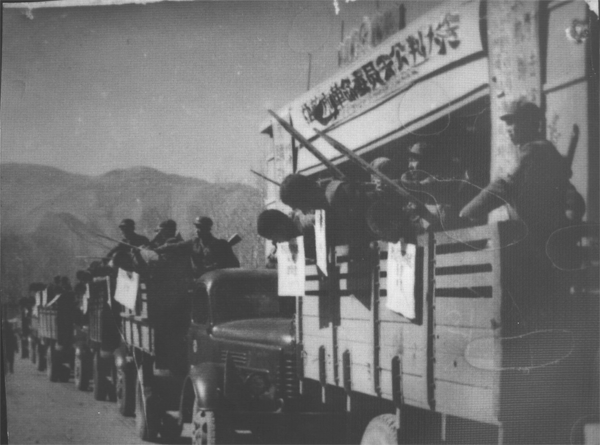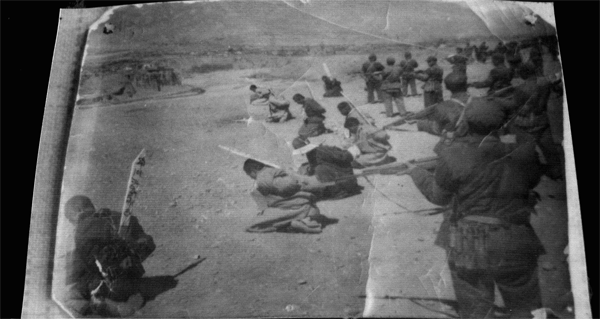ABOUT A YEAR after those Nyémo people and the Lhasa youths were arrested, and after their crimes had been investigated, they were executed at a public rally attended by many people. Numerous countries in the world practice legal execution, but they differ widely in the degree of cruelty used to actually carry it out. As for the cruelty with which it is practiced in the so-called People’s Republic of China, and particularly in the case of political offenders, I will just say something about the execution of the people from Nyémo county, which I witnessed and will never be able to forget.
There were mass executions of those involved in the Nyémo uprising on two occasions in Lhasa; seventeen were executed on the first and more than twenty on the second. A few days in advance of each execution rally, they put up posters with unrecognizable photos of those who were to be executed with Xs drawn through them in red ink and their names and crimes written underneath, on the walls of many houses in the city, along busy streets, and in the marketplace. The night before, there were general meetings in each neighborhood committee where we were told forcefully that the execution rally to be held the following day had to be attended punctually, even the sick and the elderly had to come—everyone except children too young to understand, and we could not just show up informally but had to go as a group. We “class enemies” and “hatted reactionaries under the dictatorship of the proletariat” were divided into groups along with those assigned to supervise our behavior, and there were orders for “class enemies” to be put right in the front of the crowd.
On the day of the rally, at the appointed time, citizens assembled at their respective sectional offices and lined up to be led to the place where the rally was held, the People’s Stadium, where they stood in the lots designated for each administrative division of the city. On the stage and to either side were banners of black cotton with white paper lettering reading GENERAL MEETING FOR THE SUPPRESSION OF PRESENT-DAY COUNTERREVOLUTIONARIES BY LEGAL SENTENCE and COUNTERREVOLUTION MUST BE ANNIHILATED, and loudspeakers played excerpts of Mao’s quotations put to music and other songs chosen for the occasion. On the stage were members of the Revolutionary Committee, the city government, the TMD command, and so on, as well as the People’s Court and Public Security Office. On either side of the stage and on patrol all around the assembly were military and Public Security guards brandishing weapons, to intimidate the public.
Then the leading official announced the beginning of the meeting by reading out the program, after which the loudspeakers repeatedly blared the slogan “Present-day counterrevolutionaries must be annihilated,” chanted by loud male and female voices in Chinese and Tibetan alternately. The first point on the program was a speech by an official of the TAR Higher People’s Court about the just nature of the meeting, after which he called in a harsh voice, “Bring the guilty before the court.” Thereupon, several trucks carrying fully armed Chinese soldiers, followed by several more that each carried three of the badly beaten Nyémo prisoners surrounded by soldiers, with a final truck full of soldiers in the rear, drove in slowly and pulled up in front of the stage. The Nyémo people had black placards hung around their necks with their names written on them and crossed out in red. Those placards were said to weigh ten pounds apiece and were tied around the neck with a thin knotted rope, as a way of stopping the prisoners from shouting out. Their hands were tightly bound behind their backs and tied to the rope around their necks, and as the Chinese commonly do to prisoners about to be executed, they had wooden boards affixed to the back of their necks[, sticking straight up], which are said to be driven in under the skin. The soldiers guarding them on either side kept pushing their heads down, smashing their faces against the side of the truck so that their teeth were broken and their tongues cut, and blood dribbled out of their mouths. Having been tortured in this way, they were kept in front of the public for the three hours or so that the meeting lasted, and finally, after the crimes of each one and their death sentences had been announced, the procession of trucks again drove slowly around the assembled crowd in a gesture of intimidation, and eventually proceeded to the sand embankment near Séra monastery, north of Lhasa, where they were shot and dumped in the graves that had already been dug for them. There was a kind of festival of executions that day, as similar numbers of prisoners were put to death in many counties all over the TAR.

Execution parade for the Nyémo rebels, Lhasa, 1969. Used with kind permission from Woeser.

Execution of the Nyémo rebels outside Lhasa. Taken from an official photo exhibit. Used with kind permission from Woeser.
Normally at mass rallies and other general meetings, the “class enemies” had to behave as they were told, ordinary people generally stood around in groups of two or three chatting, and went back and forth to the toilet and so on, while the leaders and activists joined in chanting slogans in loud voices and raised their fists to demonstrate their enthusiasm for “class struggle.” But on that occasion, all the Tibetans were stunned and stood there like statues, unable to move. At the beginning of the meeting, the activists appointed to supervise us “class enemies” were performing the task diligently and showing a fierce attitude of “class solidarity,” but as they watched fellows of their own flesh and blood being not only slaughtered but also tortured beforehand, they started to feel anger and disgust, and far from keeping watch on our reactions, the facial expressions of the activists themselves completely changed as their feelings became so strong that they could not help showing them.
Although people had heard many stories about Chinese massacring Tibetans before, that was in the past and such things were no longer going on in front of their eyes, but ever since the crushing of the [1959] uprising, official policy had gone from bad to worse, and now they could see for themselves something even more brutal than they had heard about before. Many of those watching could well have found themselves in the same position, since under these campaigns people were being executed not for any substantial offense but just on the basis of political remarks they were alleged to have made, as has already been described. Among the people from Nyémo there were a few with the title “Lama,” and when their crimes were announced it was apparent that they had not actually participated in the revolt. It may have been that some incident had taken place in their locality, but they were executed for “practicing superstition” just because they had that title, and there was no more serious charge against them. Contemplating how it would be if we too had been implicated in the revolt gave rise to an unbearable anxiety, and with profound commiseration we uttered prayers of yearning that neither ourselves nor anyone else should meet with such a fate and that the victims might abide in the merciful embrace of Arya Mahakarunika in all their future lives. By the end of the meeting, everyone wore a downcast expression; there were no smiling faces to be seen among the onlookers, and those who cheerfully greeted their comrades in the bustle of the crowd did so only in order to encourage each other to be brave.
The Lhasa youths were executed about a year after that [October 1970]. I did not witness it because I was working in Kongpo at the time, but for the majority of Lhasa people who did, it was a terrible and unforgettable event. They were put to death even more cruelly than the Nyémo people had been, brought before the execution rally with their arms bound so tight that their shoulders were dislocated; their eyeballs were bulging out, their faces were swollen to an unusual size, their tongues were lacerated, and blood trickled from their mouths, eye sockets, and nostrils. A few of them had already stopped breathing as a result of these tortures by the time they reached the rally. Just hearing about it was more than one could bear, not to mention actually having to watch. Nonetheless, their parents, siblings, and grandparents were obliged to come and watch, and after the rally, meetings were held for all citizens, and especially for the relatives of the youths, at which they were forced to state that the torture and execution of their beloved children was just and necessary, and to thank the authorities for doing it. The official statement of their sentence said, “These present-day counterrevolutionaries have committed the heinous crime of opposing the Communist Party, the Nation, and the People. If they were not executed, the anger of the masses could never be satisfied, and we have executed them in accordance with the demand of the masses,” thus shifting the blame for their cruel misdeeds, unheard of in the outside world, onto ordinary people.
There were several more execution rallies after that, at which five or six people were killed each time, including two of the leaders of the 1961 Tibetan Muslim agitation. There were also unpublicized killings of political prisoners in the jails, and it was said that a large number of prisoners were put to death at an execution rally in Drapchi prison for which inmates from all the other prisons were summoned. By that time, if there were no more than two or three executions at one of these rallies, we compulsory spectators would consider it a good day, as so [relatively] few people had been killed. In summary, the largest number of public executions took place in the course of that campaign, between 1969 and 1970.
Around that time, the Lhasa municipality government issued an order that every household in its jurisdiction, in both urban and rural areas, had to install a loudspeaker. There were already loudspeakers fixed on many of the higher rooftops that blared in our ears three times a day, but this was deemed insufficient, and in the name of “bringing Party policy to the doorstep,” every household was obliged to buy and install its own contraption. In this period when Tibetans were being tormented by Chinese oppression and undergoing economic hardship, a great many people suffered ill health as a result, and it was widely reported that the condition of those with heart disease (sNying rlung) worsened as a result of having to endure the din of the loudspeaker for long periods in their houses.
What they used to broadcast was how great the production achievements were under the leadership of the Communist Party, how fine the nation looked, how powerful China was, how the imperialists and reactionaries had been defeated, and how class struggle had to be relentlessly pursued, without a single word of real news. Many households from the “poor” class category cut the wires to their loudspeakers before long to shut them up, and pretended that they didn’t work anymore, but for “class enemies” there was no question of deliberately sabotaging our loudspeakers, and we even had to make sure that they didn’t stop working, lest we be accused of sabotage and lack of enthusiasm for the Party’s policies.